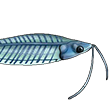Ferraz, JD, ACR Casimiro, LR Jarduli, DAZ Garcia, AS Tarkan, JR Britton & ML Orsi, 2025. Why they coexist? Ecomorphology and dietary analyses reveal trophic niche segregation in two sympatric non-native catfishes in a Neotropical river. Hydrobiologia doi:10.1007/s10750-025-05846-w.
Abstract
River impoundments created through damming increase opportunities for non-native fish introductions, resulting in increasing numbers of non-native fishes coexisting, but with the mechanisms that facilitate their coexistence often unknown. Here, the objective was to investigate the morphology and diet of two sympatric non-native catfishes (Auchenipteridae) in the heavily modified Lower Paranapanema River, Southern Brazil, the Trachelyopterus galeatus and Auchenipterus osteomystax. Samples were collected from the Rosana and Taquaruçu reservoirs across 2 years by gill nets, trawls, sieves and cast nets and evaluated for morphometrics and stomach contents analyses. There were significant differences between the catfish species across 23 morphological indices, with the major differences relating to the morphology of fins, eyes, head and mouth size. Dietary analyses indicated that A. osteomystax was a specialist that mainly consumed autochthonous resources, while T. galeatus was more generalist, mainly consuming allochthonous resources, including terrestrial invertebrates and plants. These differences resulted in A. osteomystax having a considerable smaller trophic niche than T. galeatus, with little trophic overlap between their niches. These results suggested that the morphological differences between these sympatric catfish were a key determinant of their trophic niche divergence, with this considered to facilitate the invasion success of both species in the reservoirs.
Alien invasive driftwood catfish
- Silurus
- Posts: 12472
- Joined: 31 Dec 2002, 11:35
- I've donated: $12.00!
- My articles: 55
- My images: 902
- My catfish: 1
- My cats species list: 90 (i:1, k:0)
- Spotted: 432
- Location 1: Singapore
- Location 2: Moderator Emeritus





